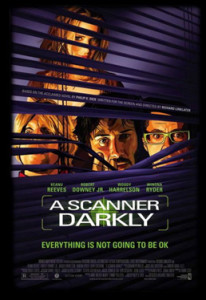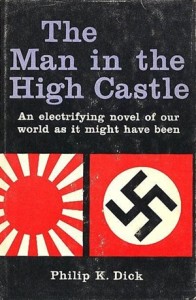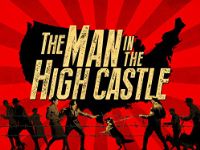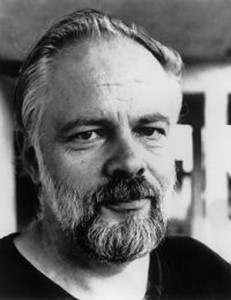Let me preface this with an admission: I am not a diehard fan of Philip K. Dick. I am not a “dickhead”, in the parlance of his devotees. It’s evident to me that the quality of his output is more varied than his admirers are willing to admit. Their reliance on that timeworn science fiction apologia—PKD was a man of “ideas”—is proof to me that his legacy is not as secure as the other sci-fi greats. Yet I return to PKD’s books once every couple of years like a miner hiking up a mountain once again, optimistic his next claim will hit the mother lode…only to so-often return home with mere nuggets or flakes for the effort.
One chestnut you’ll often hear regarding PKD is that some of the highest regarded science-fiction movies of all time are based on his work: Blade Runner, Total Recall, A Scanner Darkly, Minority Report, Paycheck. But walk that list again and you’ll discover a real mixed bag of film-making. Total Recall is fun hyper-violent nonsense. Minority Report is a toothless speculation on the future of civil rights. The hot mess that is Paycheck may be John Woo’s worst film ever.
Blade Runner is obviously a Hollywood classic, but to polish PKD’s legacy on the lapels of Ridley Scott’s masterpiece gets it backwards. As a great fan of the movie, I eagerly picked up the source material expecting something even deeper, more atmospheric, and more profound than the film—and was puzzlingly disappointed. Do Androids Dream of Electric Sheep? is neither future noir nor an edgy humanistic soul-searcher. Like so many adaptations of PKD’s work, Blade Runner is best described as based on the book’s premise. The film’s central profundity (could Deckard be a Replicant?) is crumpled-up and tossed aside by the master: in the novel, Deckard administers the Voight-Kampff test on himself and obtains a negative result. Question answered, conundrum resolved, tension dissolved. It’s not a horrible book, just preoccupied with other matters.
 Unlike Blade Runner (and every other adaptation of PKD’s work), A Scanner Darkly is striking in its fidelity to the original material. Richard Linklater’s rotoscoped gem holds up thanks to a cast who takes the material seriously but not reverently, as well as Linklater’s own confidence in the script. But is it science fiction? PKD’s semi-autobiographical take on hard drugs, drug abuse, and the surveillance state was intended to be set in then-contemporary Anaheim (circa 1971) until he was persuaded by his publisher to introduce light science-fiction touches to satisfy his readership. The decision shows, as the advanced technology (“scramble suits” that hide the identity of the main character) comes across more like a metaphor of addiction, paranoia, and altered states than the speculative scrying of a future that never arrived.
Unlike Blade Runner (and every other adaptation of PKD’s work), A Scanner Darkly is striking in its fidelity to the original material. Richard Linklater’s rotoscoped gem holds up thanks to a cast who takes the material seriously but not reverently, as well as Linklater’s own confidence in the script. But is it science fiction? PKD’s semi-autobiographical take on hard drugs, drug abuse, and the surveillance state was intended to be set in then-contemporary Anaheim (circa 1971) until he was persuaded by his publisher to introduce light science-fiction touches to satisfy his readership. The decision shows, as the advanced technology (“scramble suits” that hide the identity of the main character) comes across more like a metaphor of addiction, paranoia, and altered states than the speculative scrying of a future that never arrived.
A Scanner Darkly remains my favorite PKD novel. It’s human and humorous and touching and sorrowful. (Charles Freck’s pathetic botched suicide may be the best three pages PKD ever wrote, and is portrayed almost word-for-word in the movie.) Unlike the Bay Area’s 1960s and 1970s drug novels that preceded Darkly, PKD’s wild-and-wooly scenes of narcotics-fueled escapades are not left to stand on their own, defiant and proud of their craziness. PKD follows through to their grim consequences without blinking, flinching, or apologizing.
For all the emphasis science fiction puts on its authors’ treasured abilities to foresee our future, a survey of pre-1980s science fiction will reveal that those predictions almost entirely involve robotics, automation, and space travel. Very few predicted the scope, magnitude, and intrusiveness of the information technology revolution we are currently enjoying. Do not read science fiction for its predictive powers; you will be burned every time.
The Man in the High Castle
 Like that ever-optimistic miner in search of another vein of gold, late last year I picked up The Man in the High Castle thinking that this might be the Philip K. Dick novel that finally convinces me of his preeminence. It’s a big-premise book, to be sure, but rather than a book of “ideas” PKD offers an alternate history where the Nazis and the Japanese have won World War II, smashed down Europe and Asia, and decimated Africa. The two fascist empires spread from the opposite coasts of North America inland, and there the dust of WWII settles. The Japanese and the Germans halt their campaigns hundreds of miles apart, leaving a swath through the midwestern United States free of either’s direct control.
Like that ever-optimistic miner in search of another vein of gold, late last year I picked up The Man in the High Castle thinking that this might be the Philip K. Dick novel that finally convinces me of his preeminence. It’s a big-premise book, to be sure, but rather than a book of “ideas” PKD offers an alternate history where the Nazis and the Japanese have won World War II, smashed down Europe and Asia, and decimated Africa. The two fascist empires spread from the opposite coasts of North America inland, and there the dust of WWII settles. The Japanese and the Germans halt their campaigns hundreds of miles apart, leaving a swath through the midwestern United States free of either’s direct control.
It’s not quite the US of A—this strip of land is not run by the Constitution nor, it seems, any cohesive nation-state at all. It’s more like a No Man’s Land of diners and cineplexes that carved out its existence thanks to the two new superpowers’ reluctance to drive further inland. (I have to wonder if PKD was making some kind of statement about the Second Amendment here.) An action-oriented author would’ve launched a thriller from this starting point, something akin to the jingoistic Reagan-era Red Dawn. Fortunately, PKD’s more cerebral approach takes this supercharged premise and offers a calmer, thoughtful story of individuals caught in the middle of a brewing new war.
Those individuals are what give The Man in the High Castle a richer and more varied texture than the other PKD books I’ve read. The novel is shot through with parallel and crisscrossing story-lines: An antique broker in San Francisco caught selling forgeries; a trade bureaucrat assigned to the Japanese-controlled Pacific States of America; a Jewish jeweler hiding in broad daylight from the Germans; a Colorado waitress and an Italian truck driver who take to the road. A big-premise book with geopolitics on its mind, PKD makes the most of it. He broadens its scope in each chapter without jumping the narration to the upper echelons of power the way a more populist novel might. (How many Civil War alternate histories feature stiff scenes of Lincoln consulting his cabinet, or Jefferson Davis arguing down General Lee? Too many, I’m certain.)
High Castle even features a taste of Kremlinology. With the death of Führer Martin Boorman, the German power structure goes wobbly, leaving the characters (and the reader) to read the tea leaves and guess who will assume the levers of power. (Hitler, having gone insane due to venereal disease, was pushed out of control years before the time of the novel’s events.)
The Grasshopper Lies Heavy
The most fascinating device in the novel is The Grasshopper Lies Heavy, a book-within-Man in the High Castle that is itself an alternate history. In Grasshopper‘s telling, the Axis loses the war and the victorious United States and Great Britain (maintaining its colonial holdings) enter into a kind of global stalemate, an Anglo-American Cold War. The Soviet Union, decimated by the Nazis, never recovers in The Grasshopper Lies Heavy, or for that matter, in The Man in the High Castle.
When I first encountered the device of this alternate history inside an alternate history, it looked as though it was going to be abused. The characters discuss the book at length in some chapters. Unfortunately, they often discuss it less than artfully. But as a device for detailing the historical differences between our world and theirs, it works, albeit in a clunky manner. Other alternative histories will often use boilerplate exposition in prefaces and introductions to explain how the world of the book is different than our own. PKD moved that exposition into the mouths of his characters.
Although Grasshopper is banned in the German Reich, it seems widely available to party members and apparatchiks. It’s fashionable to discuss the book over drinks or while riding a zeppelin. The common dissemination of Grasshopper in High Castle‘s world is a nice touch; PKD understood that there’s a wide gulf between de jure and de facto censorship in totalitarian countries. Eight years before Tom Wolfe and Black Panther cocktail parties, PKD made Grasshopper “alt-history chic” in The Man in the High Castle.
Grasshopper is not the only literature discussed in High Castle. Nathanael West’s Miss Lonelyhearts and Nathaniel Hawthorne’s “Young Goodman Brown” also are referenced, but always in the kind of past tense that suggests the termination of America’s literary tradition. PKD never overlooks a chance to view America through the prism of bygone nostalgia. (Mickey Mouse watches and Civil War firearms are in particular highly prized as vintage artifacts.) It all lends to an atmosphere of a once-ascendent culture cut short by defeat and now cherished by its conquerors. The Japanese are eager to possess American culture, eager to transport it back to the main islands, but not terribly interested in emulating or absorbing it in any way—much like the West pillaged the Orient for its antiquities but not its wisdom.
Likewise, the Americans in High Castle have grown accustomed to their situation. There is little energy to fight the past wars, instead preferring to kowtow to the new regime and make do with the new reality.
Amazon’s The Man in the High Castle
 Not long after I finished reading the novel I learned that Amazon had released the pilot of a new TV series adapting The Man in the High Castle to the small screen. (You can watch the first episode here for free.) I don’t know much about Amazon’s foray into producing television content. My business association with the company is little more than filling out a couple of Web forms to sell my books. In return, they send me automated emails and the occasional bank deposit.
Not long after I finished reading the novel I learned that Amazon had released the pilot of a new TV series adapting The Man in the High Castle to the small screen. (You can watch the first episode here for free.) I don’t know much about Amazon’s foray into producing television content. My business association with the company is little more than filling out a couple of Web forms to sell my books. In return, they send me automated emails and the occasional bank deposit.
That said, I was naturally curious to see how well High Castle could be adapted to the screen, especially once I learned that Blade Runner director Ridley Scott was producing the series. Mostly I asked myself if Hollywood would once again adapt the premise of a Philip K. Dick book rather than adapt the book itself.
Watching only the first episode, I can say Frank Spotnitz’s script has plumbed the novel deeper than its back cover blurb. This is not a TV series “reimagined” from the source material. Characters and situations have been converted one-for-one, albeit with different emphases, but with a fair amount of respect for PKD’s original vision.
The show is handsome, not going overboard with period costumes or locations (although the poorly-rendered CGI backdrops of fascist New York and San Francisco give an unfortunate cartoonish effect to certain scenes). The production elected to go with gray, washed-out film coloration and drab earth tones; it looks as though World War II never really ended. In fact, the palette reminds me of the scheme used in Captain America: The First Avenger. This pilot episode could easily be a sequel to an alternate cut of that movie, one where The Red Skull crushes Captain America, leads the the Nazis across the Atlantic, and steamrolls over the Eastern seaboard with wave after wave of Panzers and A-bombs. Now, today, in this alternate 1962, disenchanted Americans in clapboard shacks watch groomed Aryans on television game shows answer insipid questions while their military service medals glint under studio lights. There’s nothing wrong with this approach per se, but when a standard-issue gunfight broke out in the first ten minutes, complete with the good-guy shooting a bad-guy preparing to shoot the good-guy’s buddy, I wondered if I was going to regret devoting myself to the 1 hour and 1 minute playing time.
Where PKD’s narration jumps about in time and space, Amazon’s production linearizes the story, simplifying motivations and situations. These Americans are not sapped of their will and making small-talk with their Fascist overlords. They’re plotting rebellion, reminiscing about fighting the good fight on the beaches of Normandy and Virginia, and, in general, dreaming of headier days of fireworks and apple pie. PKD never mocks this sort of flag-waving nostalgia, but it’s easy to see he’s not enamored with it either.
PKD’s High Castle recognizes good and evil in the world; the book is not so postmodern that it morally relativizes the Nazis, for Christ’s sake. The good done in PKD’s world springs not from baseball and the Bill of Rights, but from more basic, philosophical sources: Goodman Brown’s epiphany, the suffering in Miss Lonelyhearts, the authenticity of pure thought, the good in acting beyond one’s immediate self-interests. For the television version, goodness comes from not being a Nazi.
In the show, The Grasshopper Lies Heavy’s book form is replaced with a banned newsreel depicting stock footage (our stock footage, not the alternate universe’s) of VE- and VJ-Day sailors in dress whites kissing women in Times Square, US marines raising the flag at Iwo Jima, Madison Avenue ticker tape parades, and so on. So explosive is this 8mm film, Americans are shot in the streets for possessing it; so moving, it drives a grown woman to tears upon her first viewing. This is the MacGuffin (of sorts) driving the episode and presumably the entire series: get that canister of film to Canon City, Colorado, and into the hands of the presumptive American rebel force. The producers of that failed Red Dawn remake are probably slapping their foreheads right now.
Having seen only one episode, it’s too early to damn the enterprise as a whole. I do wish that Hollywood could, for once, give us our due. There’s plenty in PKD’s High Castle for modern viewers to sink their teeth into. The alternate history PKD offers is surprisingly tasty. I could easily imagine the show recounting it (starting with FDR’s assassination) in the vein of Oliver Stone’s JFK, repeating events from different perspectives to emphasize the malleability of history. I haven’t even touched on the importance of the I Ching to PKD’s book, which is mentioned only briefly in the first episode. Knowing how the novel ends, I have to wonder how the show will weave the I Ching into the series. Or will they simply treat it as Oriental mysticism—a shame, considering how much respect PKD gives it as a source of meditation and reflection. (As well as it’s centrality to the book’s genesis and execution; PKD used the I Ching to generate early drafts.)
PKD’s novel wraps up not with explosions or theatrics—scrappy American rebels rappelling into Nazi High Command—but a lively discussion at a cocktail party. The Man in the High Castle is not a book of tidy endings. In the concluding pages, story lines open up rather than shut down. Philosophical questions lead to more questions. I’m not terribly optimistic that the TV series will see the wisdom in this. Fourteen years after 9/11—a decade and a half of US invasion and occupation, civil rights forfeitures, and the tightening omniscience of our surveillance state—I would hope that the producers of The Man in the High Castle would see the wisdom of not romanticizing the resistance against an occupation of the American homeland. Still, Spielberg and Tarantino both proved that the Nazis are the neatest, tidiest, most easily expedited film villains you can toss onto the screen. No reason to waste all that easy loathing in a story where they don’t get their violent, satisfying comeuppance.

